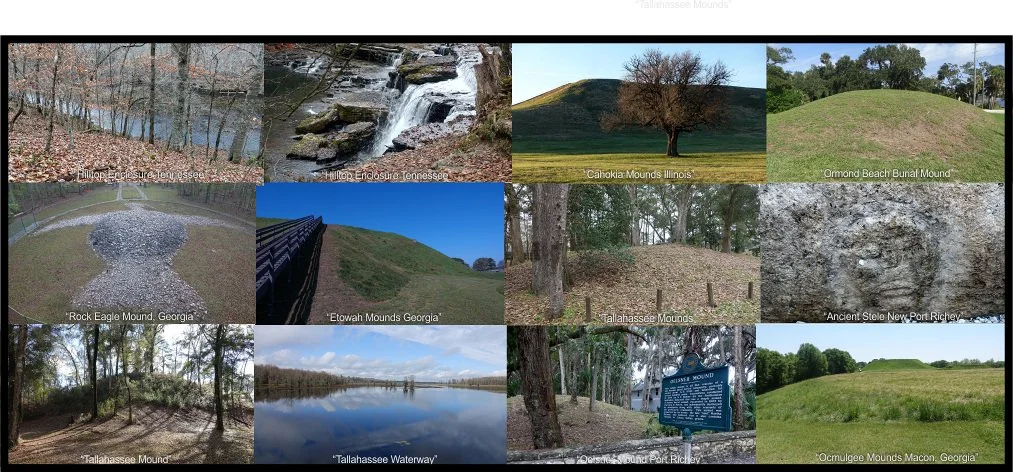How many Indigenous Mounds can you find in your neck of the woods?
Prelude:
(reference images and video provided)
Honoring the Original Inhabitants and their beloved progeny, Lillie and I designed a plan to see as many ancient mound locations as we could reasonably afford over the years. In order to experience the most sacred monuments still remaining in the Americas, a study of ancestral and historical maps was required. We are thankful to the librarians, curators, and historians who have helped along with the many fireman, park rangers, and kind people who offered needed assistance. These concerted efforts helped us fine-tune our scope of travel to these sacred sites. Our travels meandered toward areas both remote and at “modern town/cites” with each journey gaining astoundingly rewards.
There are numerous times when traveling near ancestral gathering places offered clarity of thought and balance of body. Knowing that these monuments before us were built, shared and enjoyed by the genetic essence of “human” experience is humbling. What is described as ”North American Indigenous Culture” leads to a profound appreciation of the Cultura Madre who divinely gifted our physical entrance upon the land. Peace be unto our dear Mother Clan.
We focused our attention to travels near our abode and eventually traveled far in the pursuit of pristine truth. We intently directed our studies upon Southeastern Indigenous Cultures and beyond. Upon these fertile lands, on which we stand, we have uncovered diamonds and pearls of wisdom honoring the Original Inhabitants in the South, Central and North Americas, unto the multitudinous islands united by great water. The fresh water creeks unto rivers divinely provided, offer the most gracious of gifts along with the fresh air and sunlight.
As Creative Fate would have it, our efforts and footsteps unveiled a baffling journey and the formation of a 12-Part Mound Appreciation Guide, one of which we welcome your generous insights and support. DiamondLegacyAmerica.org planned and followed through on a series of journeys to thoroughly document and present these findings. When one considers the concerted and strategic “corporate policy” to withhold this pertinent information from “Educational Systems“, it becomes increasingly apparent that children of all ages are at risk for being adversely effected.
It is our responsibility as heirs of this divine estate to effectively share our findings. Peace be upon you and your beloved during your noble travels.
Gather blissful memories while leaving spirited footprints.
Brother Jamal
Let’s get Started!
PART ONE
Monuments Featured: “Town Creek Mound”, “Grave Creek Mound”, “Santee Mound”, “Wycliff Mound”, “Reynolds Farm Mound”
Town Creek Mound, Mt Gilead, North Carolina
Situated on a terrace about 16 feet above the surrounding floodplain, this location signifies the presence of Original Inhabitants who built a platform mound, sacred mortuary houses and other village structures along the Little River, a tributary of the Great Pee Dee River. Enduring damage from numerous excavations, the mound and on-site buildings were reconstructed. A 2009 archaeological report documented collection of additional human burials, a Clovis point, over 30,000 artifacts, and other research.
video brief of a journey to the “Town Creek Mound, North Carolina”
Grave Creek Mound Complex-Moundsville, West Virginia
This spectacular monument is said to be one of the largest conical burial mounds built in stages by so-named Adena people (250 to 150 BCE). Standing about 70 feet tall with a circumference of 910 feet, it is also known as the Mammoth Mound. Early records (1838) show that amateurs dug tunnels into this structure uncovering human remains and grave goods. In 1866, it is claimed that a large 4-story brick prison facility was estalished on the "leveled" grounds of the ancient burial location. The first excavation by archaeologists occurred in the 1970s, documenting Indigenous skeletons and artifacts which enabled carbon dating of this prehistoric mound. Evidence of a 40-ft wide ditch and causeway leading to the top. The sacredness of this mound and legacy of the prolific habitation by First Nation People across the entire region is acknowledged and preserved for posterity.
“Grave Creek Mound Complex-Video-Brief Moundville, West Virginia“
Santee Mound – Santee, South Carolina
This amazing monument is shaped like a truncated pyramid, stands around 25 feet tall, and signifies extensive habitation by Santee People—an ancient Mississippian "culture" existing at "South Carolina" territory. A second (smaller) mound exists nearby in a forested area and archaeologists surveyed both, acknowledging borrow pits, sacred burials, artifacts and a low area that is only dry in the winter. This Indigenous site is located near the Santee River, at so-called Scott's Lake and "Lake Marion" (constructed later).
Video brief of a journey to “Santee Mound“
Wickliffe Mounds – Wickliffe, Kentucky
The wonder-filled views while crossing the bridge structures over the confluence of the Ohio and Mississippi Rivers are quite fascinating. However, experiencing the ancient Indigenous village located just a short distance away at "Wickliffe, Kentucky" is more gratifying. This Archaeological Landmark, established by ancient Mississippian people, encompasses areas along bluffs that overlook the river and features two platform mounds, several burial mounds, plaza, fields, and homes. In addition to massive burials and artifact recoveries, archaeologists documented a symbol of the cross-and-circle or Sun Circle—a Mississippian and Southeastern Native American art symbol shown on pottery and shell/stone objects.
video brief of a journey to “Wickliffe Mounds“
“Reynolds Mound- St Marys - West Virginia”
This captivating ancient monument graces the circle entry to the Mound Manor neighborhood, which is located near the Ohio River at “Saint Marys, West Virginia”. The so-named Reynolds Mound was part of the Adena culture (known as moundbuilders) which thrived and built significant mound structures inside villages around the region and other territories like Chilicothe, Ohio. Archaeological studies document that these great people (ancestors of so-called Hopewells) provided sustenance, created ceramics, tools, artworks, etc.), and established extensive waterway trade networks.























